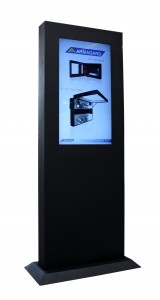Thousands of different televisions are on the market. From varying screen sizes, different technologies such as plasma and LCD, and they come in a wide variety of costs brackets. For outdoor digital signage, commercial grade screens provide a longer-lasting solution but there are also two other technologies that are essential for using a screen outdoors.
High Definition

Most televisions are now HD ready. High Definition provides a resolution far higher than that of a traditional television. High definition usually has over a million pixels per frame, normally five times greater than standard TV definition. HD provides a far clearer and noticeable image, ideal for attracting the attention of passersby.
Any High Definition on an outdoor digital signage screen, however, needs uploading and playing using a HD media player otherwise the will revert to standard definition on the screen.
High Brightness
Different to High Definition, high brightness screens are essential for locations with conditions of high ambient-brightness, such as outdoors. The standard brightness of a TV screen used at home is about 600 candela (a unit of luminance, also known as nits). The problem with outdoor areas is that often the ambient-brightness can often be higher than the brightness of a standard LCD screen. For this reason, high brightness screens are required for better visibility.
High brightness screens come with candela values several times greater than standard brightness displays. The brighter the outdoor area, the brighter the screen required, especially if the screen is facing the path of the sun to prevent glare from inhibiting the viewability of the screen.
Traditional LCD TVs used fluorescent lighting to generate the brightness of the display. Not only do these systems use large quantities of power, but they also generate lots of heat. Modern high brightness screens, however, implement LED technology to generate brightness. These provide just as much luminance as fluorescent system but use far less power and generate less heat. LED backlit LCD TVs also have a longer half-life than fluorescent systems, providing higher brightness levels for a lot longer.